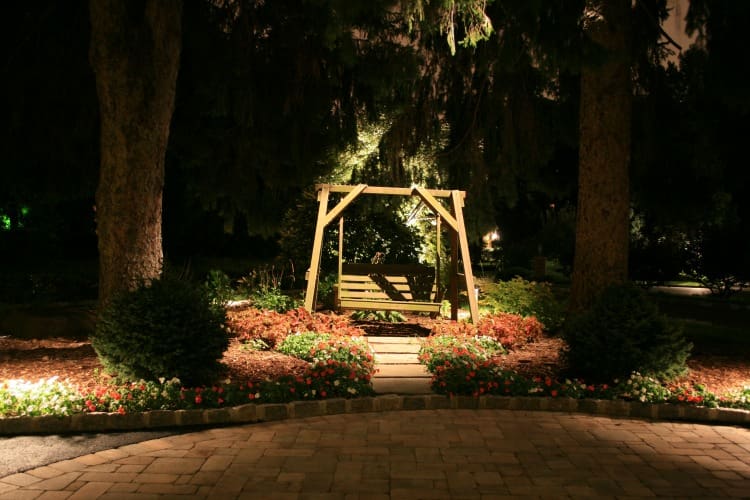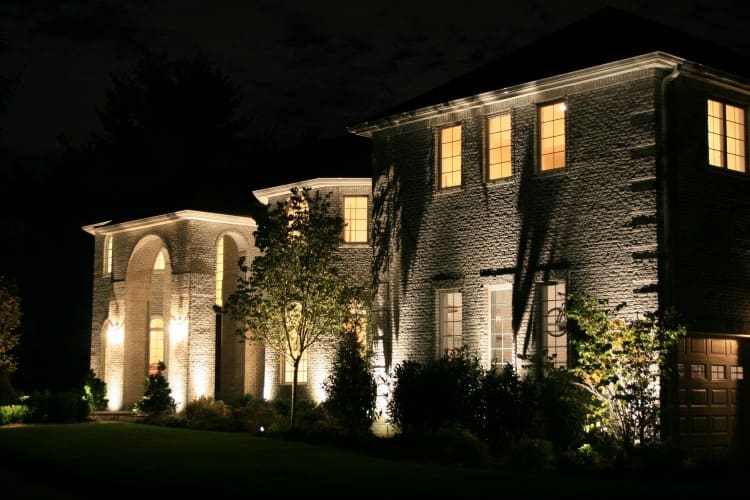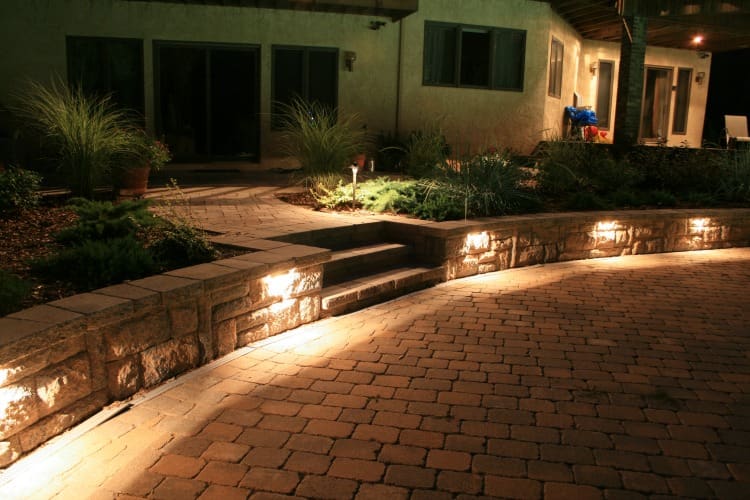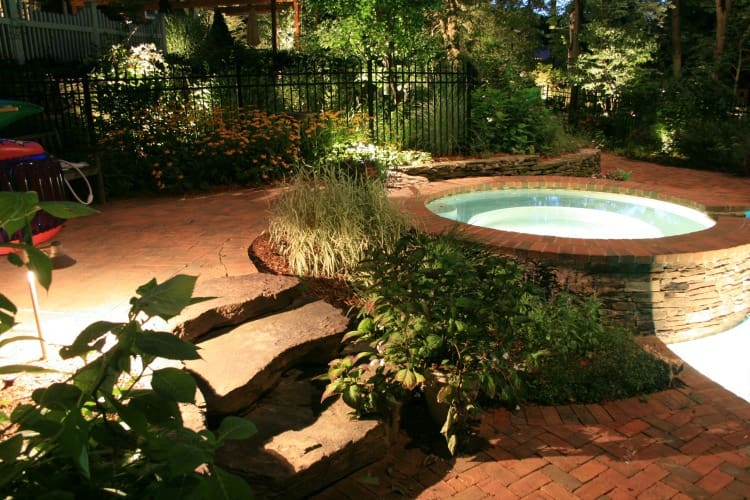How do you create a landscape with stunning design appeal? One way is to make outdoor spaces beautiful and usable at night with landscape lighting in NJ. Outdoor lighting will create an inviting entrance, provide spaces for entertaining after dark, enhance your home’s style and increase curb appeal and property value. Landscape lighting offers so many benefits for your Northern NJ home at relatively low costs.
To get a professional look, it’s important to determine your landscape lighting goals, then create a well-designed plan to accomplish them. If you haphazardly install lighting fixtures in the yard, they may serve no real purpose and create a landscape with lackluster appeal. For best results, consider hiring a landscape company like Borst Landscape & Design that specializes in professional landscape lighting in NJ.
Define Your Landscape Lighting Goals
Before you invest in any landscape lighting, it’s important to define your landscape lighting goals. Start by asking yourself some helpful questions:
- Do you want to create an inviting entrance to your home?
- Do you need safe footpaths for walkways and pathways?
- Do you need additional security for your property?
- Do you want to create functional outdoor areas for entertaining?
- Do you have outdoor features that you want to showcase?
Perhaps you want to create a soft, romantic mood during evening hours. Maybe you want to mark property boundaries and illuminate dark areas. Perhaps you want to highlight an outdoor fountain or a lovely koi pond. Whatever your goals are, landscape lighting will instantly transform your yard and provide beautiful night time ambiance.
Create a Lighting Design Plan
To create a good landscape lighting plan, it helps to walk around your yard after dark to get a realistic picture of your landscape and outdoor spaces after the sun goes down. By gaining perspective at night, you can best determine what areas need visual interest, what spaces need function and what features need special focus.
Once you determine where you need light, you can select the type of fixtures that will provide proper lighting for those areas. Landscape lighting in NJ is available in a wide variety of fixtures and finishes that will complement any architectural style home, so it’s easy to find lighting fixtures for every type of landscaping project.
When choosing outdoor lighting fixtures, think about existing structures, trees and shrubs, plants and vegetation, decorations in the garden and features in the yard. Estimate the height of objects and foliage where you want to place the lighting. All of these items will either reflect light or absorb it. A well-lit landscape should have both functional and decorative lighting, so outdoor lighting fixtures are typically divided into three basic groups:
- Overall Lighting – Provides illumination for an entire area or space. Ceiling mounted fixtures or recessed lights provide good overall lighting for outdoor patios, pavilions, pool cabanas, and other outdoor structures with a roof.
- Task Lighting – Used to create light for a specific task. Wall mounted porch lights illuminate the front entrance and doorbell to welcome guests, while pathway and step lights provide a safe footpath for driveways, walkways and exterior steps.
- Accent Lighting – Used to draw attention to a certain areas or objects. Up-lights, spotlights and floodlights provide excellent accent lighting for trees and landscape features such as fountains, waterfalls, fences and garden areas.
For best control of your landscape lighting in NJ, put your lighting on timers. Timers are the easiest and most reliable automatic lighting controls and can be used to make lighting adjustments for seasonal changes and time changes. Wireless keypads and lighting apps provide convenient ways to manually control your lights and, unlike hardwired switches, don’t require an electrician for installation.
Professional Landscape Lighting Effects
Once you determine your lighting goals and create a well-planned lighting design, you can create a landscape with stunning night time appeal. By choosing the right fixtures and using proper placement you can give your home and landscape a magical ambiance. Take a look at five outdoor lighting effects used by the pros for landscape lighting in NJ.
Up-Lighting
This lighting technique is used to highlight landscaping and structures from the ground up. To light trees, place one or two fixtures at the base of the tree and angle the fixture upwards towards the main trunk structure. To highlight the tree’s canopy and branches, place the fixture about 8 to 10 feet away from the tree truck and angle it upwards. The added distance will force a wider light beam that will hit higher up in the tree. Trees less than 20 feet tall only need a couple of 20-watt up-lights. Taller trees may require three to five up-lights, each with 35 to 50 watts. To avoid getting water in up-lights, you can choose fixtures that have a convex lens. This will force the water to run off the light.
- Bullets – These versatile, compact fixtures are fitted with bulbs that project a narrow, bright beam. Bullet fixtures are good for highlighting architectural house features, tree trunks, and garden structures.
- Floods – Floodlights cast a wider beam than a bullet, about 40 degrees or more. Floods produce strong, bright light that creates a dramatic look for tall trees and structures. Most flood fixtures have a collar that helps to minimize side glare.
 Down-Lighting
Down-Lighting
Down-lights can be used for landscape lighting in NJ to accent seating areas, walkways and pathways, garden beds and special outdoor features. When placed under the eaves of the house or roof line, they will create soft light that draws attention to doorways, windows and architectural features and materials on the house. You want to install a down-light fixture just high enough to spread a circle of light around the feature you wish to emphasize.
- Walkways and Pathways – Pathway lighting provides a safe footpath for walkways and pathways. When placing fixtures, focus on creating a directional path, rather than an outline for the shape of the walkway or pathway.
- Garden Beds – To properly illuminate a garden bed, lighting fixtures must be taller than the foliage and plants that you want to showcase. Measure the height of foliage and plants before you select down-light fixtures for garden beds.
 Moonlighting
Moonlighting
Unfortunately, you can’t just call up a full moon when you want one, but you can create the effect of moonlight with the right landscape lighting in NJ. To create moonlighting effects, down-light fixtures are often located high up on tree trunks and branches with light directed downward through the foliage. The leaves and branches of the tree will cast interesting shadows on landscape areas, patio areas, walkways and pathways and outdoor features below. To create multiple shadows and textures, you can place several lighting fixtures high up in the tree branches and cross the light as it filters downward.
When choosing fixtures, it’s best to choose durable copper and brass housings with LED bulbs that are long lasting. That way, you don’t have to worry about climbing up the tree frequently to replace bulbs or make lighting repairs. Select down-light fixtures that have a long, cowl-shaped shroud around the bulb to eliminate harsh side glare.
Shadowing
Shadowing techniques are used to cast shadows on features that you want to highlight. These techniques draw attention and create focal points in the landscape. By washing a tree or shrubs and plants, you can cast a soft shadow on a nearby fence or a retaining wall. The play of light and darkness created by shadowing can be very intriguing, especially if washed objects are moving in the wind. For a dramatic effect, place the light fixture low to the ground and angle the light fixture upward.
- Wall Washers – These fixtures throw out a soft, diffused light that’s ideal for brightening exterior facades, privacy fences, and garden and retaining walls. Round, flat heads keep light from projecting in a stream, like with spots and floods.
 Grazing
Grazing
Grazing is a lighting technique that’s used to highlight interesting architectural materials and textures, as well as landscaping. To create grazing effects, place up-lights right next to a structure wall with light beams directed upwards. The light will cast shadows that softly capture the materials and textures of the wall. If your house has interesting materials like limestone, flagstone, brick or wood, grazing will bring out the beauty of the architecture and emphasize textures. Grazing techniques can also be used to highlight interesting materials and textures on retaining walls, fences, outdoor fireplaces and other landscape structures.
Well lights work well for grazing techniques. They are in-ground fixtures, so there are no fixtures to stumble over or detract from landscaping features. The bulb hides inside a waterproof housing that’s buried in the ground, so you get light without seeing a fixture. Waterproof LED well lights are a great way to accentuate textures in trees, large shrubs and architectural features like walls, columns and special outdoor features. Wells can also be used to illuminate the underside of plant foliage or graze the base of a facade or wall. Well lights are available with either fixed or swiveling bulbs.
If you want a beautiful landscape with stunning, night time appeal, don’t dismiss the importance of landscape lighting in NJ. Give us a call at Borst to discuss outdoor lighting possibilities for your Bergen County landscape.

 Down-Lighting
Down-Lighting Moonlighting
Moonlighting Grazing
Grazing